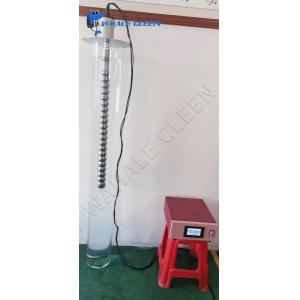

Add to Cart
20KHz 1500W Ultrasonic Rod Transducer Ultrasonic Homogenizing Emulsified Vibrating Rod Ultrasonic Reactor For Biodiesel
Ultrasonic Preparation of Nanoscale Devices
• Particle size uniformity, strong dispersion, crystal type
control, simple preparation, high yield
• Ultrasound nano-fabrication of monodisperse, well-defined
nanoparticles and reduced energy consumption
• Ultrasonic nanoprocessing is easier to achieve mesoscopic mixing
than conventional mixing techniques, eliminating local
concentration variations, increasing reaction rates, stimulating
the formation of new phases, inhibiting reunion
Probe sonication is significantly more powerful and effective when
compared to ultrasonic cleaner baths for nanoparticle applications.
A cleaner bath requires hours to accomplish what a probe Sonicator
can do in minutes. Sonicators can create a stable dispersion that
can remain in suspension for many months as evidenced in this
article excerpt:
Dispersions in vials (a) have coagulated CNTs in the body and at
the bottom by means of bath sonication for 8 hours, (b) appear
free-homogenous with probe sonication for 3 minutes, and (c) keep
free-homogenous even after 4 months of sitting at room temperature.
The concentration of Multi-Walled Carbon Nanotubes (MWCNTs) is 2500
mg/L and the MWCNTs/SDS ration is 1:10. (d) MWCNTs of (c) was
diluted to 25 mg/L with deionized water.
Applications:
Ultrasonic have extremely capable and versatile, it can safely
process a wide range of organic and inorganic materials – from
microliters to liters. Typical applications include: sample
preparation, dispersion, cell lysing, desegregation,
homogenization, particle size reduction, soil testing,
transesterification (including biodiesel production),
nanotechnology (including nanoparticle and Graphene dispersion),
acceleration of chemical reactions, degassing and atomization.
The new digital ultrasonicator is a powerful ultrasound processor
for liquid treatments on bench-top and industrial scale. Common
applications include homogenization, emulsification, dispersing
& particle fine milling, lysis & extraction, dissolving
vagy sonochemical reactions such as sono-synthesis and
sono-catalysis. Touch display, browser remote control, automatic
data recording. High Power and Full Process Control Powerful
sonication is the process solution for manifold liquid processing
applications, such as emulsifying, dispersing, milling vagy
dissolving. The equipment provides intense ultrasound waves to
fulfill demanding tasks without problems. To ensure a consistent
process quality, not only the power delivered is essential, the
control and monitoring of all important process parameters is key.
The new generation of hdT ultrasonicators enables the operator to
pilot the ultrasonic device via touch display or browser remote
control.
What Is an Ultrasonic Rod Transducer?
Ultrasonic Rod transducers are designed to let the piezo element create its ultrasonic vibrations across a cylindrical, tube type element. The design allows the system to generate an ultrasonic wave in an omnidirectional way ¯ the waves radiate in all directions from the source, not just in one direction like traditional surface plane mounted transducers.
What Ultrasonic Rod Transducers Mean to You
Because the ultrasonic waves radiate in all directions from the source, every volume of your ultrasonic tank is actively creating ultrasonic cavitations. That means that every surface area of every item you put into the tank is exposed to the cleaning action. No dead spots.
|
Customer's feedback:
